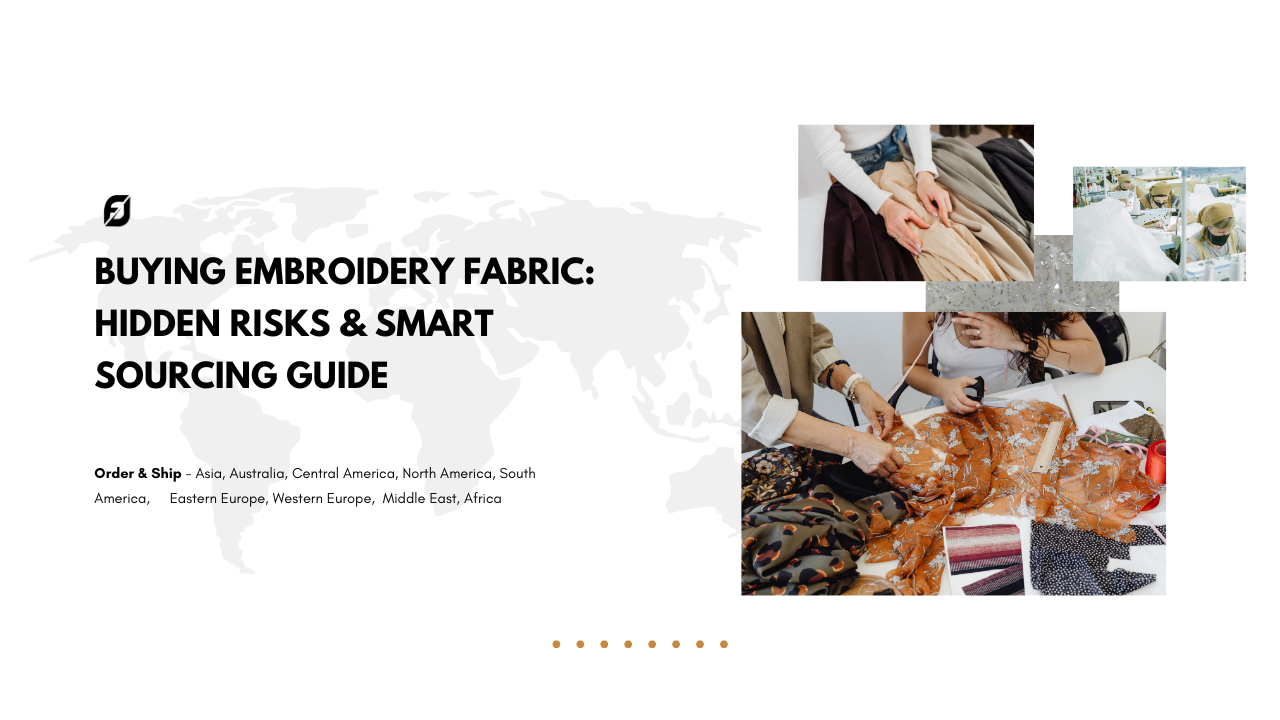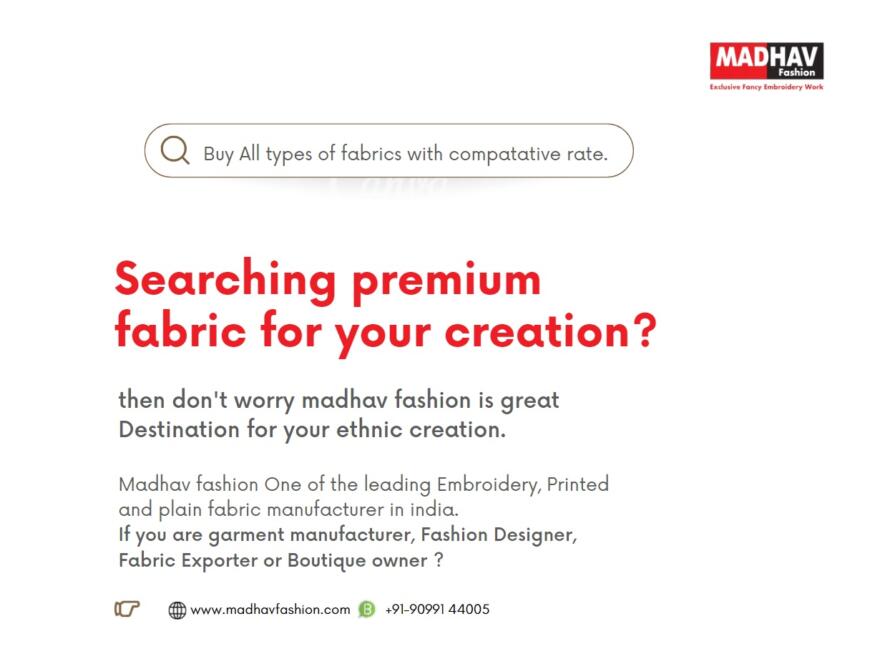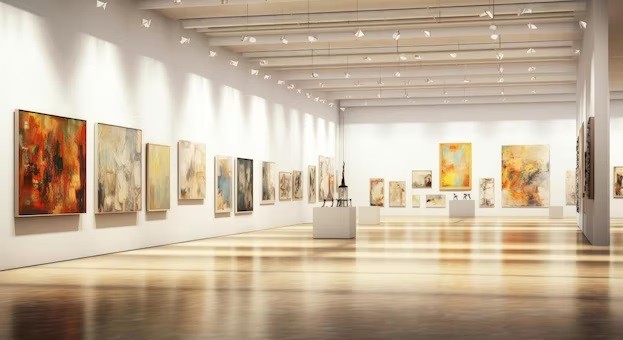Embroidery has been a timeless art form that elevates garments from mere attire to works of wearable art. The choice of fabric plays a pivotal role in enhancing the beauty of embroidered designs.
In this blog, we explore the most popular embroidery fabrics that fashion enthusiasts and designers favor for creating stunning garments that stand out in terms of both style and craftsmanship.
Most Popular Embroidery Fabrics for Garment Creation
- Cotton: The All-Time Classic
Cotton, known for its breathability and versatility, is a favored fabric for embroidery. Its smooth surface allows for intricate stitching, making it ideal for detailed and elaborate designs. Whether it’s a casual summer dress or an elegant blouse, cotton serves as a canvas for various embroidery techniques.

- Silk: The Epitome of Luxury
Silk has long been associated with luxury, and its natural sheen makes it a favorite for embroidery. From traditional silk sarees adorned with intricate threadwork to modern silk dresses featuring contemporary embroidery patterns, this fabric adds a touch of opulence to any garment.
- Linen: Casual Elegance
Linen’s textured surface and relaxed drape make it a popular choice for casual yet elegant embroidered garments. Whether it’s a linen tunic with subtle embroidery or wide-legged embroidered linen pants, this fabric exudes a laid-back sophistication that’s perfect for various occasions.
- Chiffon: Delicate and Dreamy
Chiffon, with its sheer and lightweight nature, provides a delicate canvas for embroidery. Often used for evening gowns, sarees, and dupattas, chiffon allows for intricate and ethereal embroidery designs that float gracefully on the fabric.
- Velvet: Luxurious Embellishments
Velvet’s plush texture creates a luxurious backdrop for embroidery. Popular in eveningwear and festive attire, velvet garments featuring intricate threadwork or bead embroidery add a rich and regal touch to the overall look.

- Denim: The Edgy Embroidery Canvas
Denim has evolved beyond its utilitarian roots to become a canvas for expressive embroidery. From denim jackets with floral embroidery to embroidered jeans, this fabric adds a trendy and edgy element to embroidered garments, appealing to a diverse range of styles.
- Georgette: Flowing Grace
Georgette, with its flowing and lightweight quality, is a popular choice for embroidered dresses and sarees. The fabric drapes beautifully, allowing for elegant and flowing embroidery designs that enhance the overall movement of the garment.
- Satin: Smooth Elegance
Satin’s smooth and glossy surface makes it an excellent choice for embroidery that demands a sleek finish. Whether used for embroidered bridal gowns or evening dresses, satin provides an elegant base for intricate and finely detailed embroidery work.
The world of garment creation is a testament to the seamless integration of embroidery with various fabrics. Each fabric brings its own unique qualities, enhancing the visual appeal of embroidered designs.
As you embark on your next fashion journey, consider the characteristics of these popular embroidery fabrics to create garments that not only showcase exquisite craftsmanship but also resonate with individual style preferences.

Madhav Fashion, a leader in the textile industry, recognizes the significance of these fabrics, crafting a diverse range of designer butta fabrics that exemplify the beauty of embroidery on different textile canvases.
Explore the endless possibilities and let your creativity flourish as you weave intricate tales of style and sophistication through the art of embroidery.
1. What is the best fabric to use for embroidery?
The best fabric for embroidery depends on the desired outcome. Cotton, linen, and silk are popular choices due to their smooth and stable surfaces. Madhav Fashion recognizes the significance of choosing the right fabric, offering a range of options in their collection of designer butta fabrics, ensuring the perfect canvas for intricate embroidery work.
2. What is the most popular type of embroidery?
Among the most popular types of embroidery are cross-stitch, satin stitch, and chain stitch. Each type offers a unique texture and visual appeal. Madhav Fashion, as a leader in the textile industry, incorporates these popular embroidery techniques into their diverse range of butta fabrics, catering to various design preferences.
3. What is the common fabric used in embroidery?
Cotton is a common and versatile fabric used in embroidery. Its smooth texture allows for detailed stitching, making it suitable for various embroidery techniques. Madhav Fashion understands the importance of this classic fabric, often incorporating cotton into their designer butta fabrics to provide a timeless and comfortable base for embroidery.
4. What clothes to use for embroidery?
The choice of clothing for embroidery depends on the project. T-shirts, denim jackets, and cotton dresses are popular choices. Madhav Fashion’s expertise lies in crafting designer butta fabrics suitable for diverse garments, ensuring that the fabric complements the embroidery technique and enhances the overall aesthetic.
5. What GSM for embroidery?
The GSM (grams per square meter) for embroidery depends on the fabric’s weight and thickness. Common choices range from 180 GSM for lightweight fabrics to 300 GSM for heavier options. Madhav Fashion offers a variety of GSM options in their butta fabrics, allowing for flexibility in choosing the right weight for different embroidery projects.
6. Is polyester or cotton better for embroidery?
The choice between polyester and cotton depends on personal preference. Cotton is often favored for its natural feel, while polyester offers durability and resistance to wrinkles. Madhav Fashion, understanding the importance of choice, includes both polyester and cotton options in their collection of designer butta fabrics to cater to diverse preferences.
7. What are the four famous embroidery?
Four famous types of embroidery include cross-stitch, crewel embroidery, canvas work, and blackwork. These techniques showcase different styles and patterns. Madhav Fashion embraces the diversity of embroidery, incorporating elements of these famous styles into their butta fabrics, creating a collection that resonates with various artistic expressions.
8. Which embroidery is costly?
Goldwork embroidery is often considered one of the costliest embroidery techniques. This opulent style involves using real gold or gold-plated threads, adding a luxurious touch to garments. Madhav Fashion appreciates the allure of such intricate craftsmanship, occasionally incorporating goldwork elements into their designer butta fabrics for those seeking a touch of extravagance.
9. What is the most expensive type of embroidery?
Goldwork embroidery, utilizing genuine gold threads, is renowned as one of the most expensive types of embroidery. The precious materials and meticulous craftsmanship contribute to its exclusivity. While goldwork may be a high-end choice, Madhav Fashion ensures that even their most luxurious butta fabrics remain accessible, allowing customers to experience opulence without compromise.
10. What is embroidery fabric called?
The fabric used for embroidery is often referred to simply as “embroidery fabric.” It can vary from cotton and linen to silk or blends, depending on the desired effect. Madhav Fashion’s designer butta fabrics serve as the perfect embodiment of embroidery fabric, providing a high-quality canvas for exquisite stitching and embellishments.
11. What clothing is easiest to embroider?
Cotton clothing is often considered the easiest to embroider due to its smooth surface and stability. Madhav Fashion acknowledges the ease of working with cotton, incorporating it into their collection of designer butta fabrics to ensure that both novice and experienced embroiderers find the ideal base for their creative endeavors.
12. Is linen good for embroidery?
Yes, linen is an excellent fabric for embroidery. Its textured surface adds depth to embroidered designs, and it becomes softer with each wash. Madhav Fashion recognizes the versatility of linen, incorporating it into their designer butta fabrics to offer a unique and sophisticated option for those seeking a distinctive texture in their embroidered garments.






